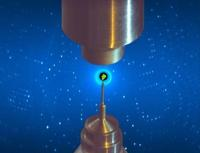Speaker
Description
The dynamical properties of lipid membranes play an important role in how cells, virus and organelles interact with the world around them. These properties arise from a complex interplay of forces over a wide range of time and length scales and, as such, are ideally suited for study with neutron spin echo (NSE) spectroscopy. Recently, the NSE technique has been extended to grazing incidence geometry, allowing in-plane collective motions to be investigated in lipid membrane multilayers. The results indicated the presence of a new type of collective oscillation not previously observed in soft-matter samples - the so-called surface mode phonon. Here, we introduce the model developed to interpret the results of these experiments.
The model is an extension into the time domain of work done by Romanov and Ul’yanov on the structural and dynamic properties of smectic films. By comparing the results of the NSE experiment and the output of the model for various realistic parameter sets, we examine how the model can be used to interpret grazing incidence NSE data. We also consider at how the model has been implemented and the effects that this has on the stability and validity.
Finally, we look at some of the ongoing molecular dynamics simulation work at JCNS-4 and how this fits in with the push to extend recent work on model phosphatidylcholine-based membranes to more biologically relevant natural membranes featuring a diverse range of lipid classes.

